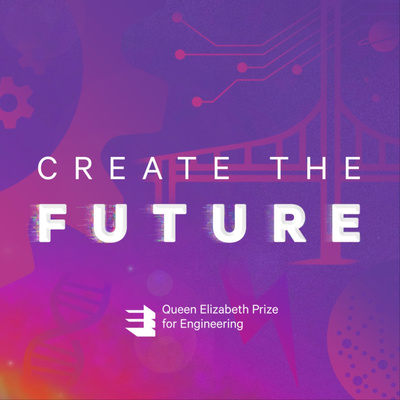
Create the Future: An Engineering Podcast
By Queen Elizabeth Prize for Engineering
The world’s leading award for engineers and engineering, the Queen Elizabeth Prize for Engineering (qeprize.org) champions bold, groundbreaking engineering innovation which is of global benefit to humanity.
Season 3 begins January 2022.

Create the Future: An Engineering PodcastFeb 21, 2020

The Future of LED Lighting
In this Season 2 finale episode of the Create the Future podcast we speak to Stephen Rouatt, CEO of the UK & Ireland markets for Signify (formerly Philips Lighting) about innovations in LED lighting. We discuss the innovative ways in which the 2021 QEPrize winning technology is being used today, consider the future uses of LED lighting, and Stephen tells us why engineers often make great entrepreneurs.
We’ll be back in January 2022 with Season 3. In the meantime, subscribe to us here on your podcast app and follow @qeprize on Twitter, Instagram, and Facebook so you don’t miss us when we come back!

5G and The Internet of Skills
Mischa Dohler is a telecommunications innovator known for his pioneering work on 5G wireless communications, the Internet of Skills, and Smart Cities.
In this episode of Create the Future, we speak with Mischa about what 5G is and how might improve our lives. We discuss the improvements made to cellular networks since the days of 2G, why collaboration in telecommunications and engineering is becoming increasingly important, and how Mischa managed to combine his love for music and technology in the world’s first 5G concert.
New episodes of ‘Create the Future: An Engineering Podcast’ every other Tuesday. www.qeprize.org/podcasts

The Mathematics Behind GPS: Dr Gladys West
Dr Gladys West is a pioneer in the use of complex mathematics and efficient programming to generate accurate, repeatable and global models of the Earth’s geoid that were eventually incorporated into the mapping functions of the Global Positioning System (GPS). This work required her to process early satellite data and use complex algorithms to account for variations in gravitational, tidal, and other forces that distort Earth's shape.
In this episode of Create the Future, we speak with Dr West about the methods she employed to calculate an accurate geodetic earth model using a room-sized computer. We discuss her early career, hear what it meant to be awarded the Royal Academy of Engineering’s Prince Philip Medal in 2021, touch on her continued passion for education, and ask whether she uses GPS today.
To hear more about the engineering behind the Global Positioning System, check out our episode with the winners of the 2019 Queen Elizabeth Prize for Engineering.
New episodes of ‘Create the Future: An Engineering Podcast’ every other Tuesday. www.qeprize.org/podcasts

Engineering mRNA Vaccines
Dr Margaret Liu, known as The Mother of DNA Vaccines, is President Emeritus of the International Society for Vaccines and scientific lead for the World Health Organisation drafting group writing guidelines on mRNA vaccines.
In this episode of Create the Future, we speak with Margaret about all things mRNA vaccines and how they came to play a role in the largest immunisation programme in recent times. We discuss vaccine manufacture and clinical trials, explore the advantages of mRNA vaccines, and find out about the well-timed biotechnology and engineering breakthroughs behind them.
New episodes of ‘Create the Future: An Engineering Podcast’ every other Tuesday. www.qeprize.org/podcasts

Facial Recognition
Charlette N’Guessan is the technology entrepreneur behind BACE API, a software that uses facial recognition and artificial intelligence to verify identities remotely. In 2020 Charlette was awarded the Royal Academy of Engineering’s Africa Prize, Africa’s largest prize dedicated to engineering innovation.
While facial recognition software isn’t new, BACE API uses live images or short videos taken on in-built phone cameras to detect whether a person is real, or just photo. During the global pandemic, BACE API emerged as a viable and secure solution to the “know your customer” (KYC) challenge faced by financial institutions.
New episodes of ‘Create the Future: An Engineering Podcast’ every other Tuesday. www.qeprize.org/podcasts
Follow @qeprize on Twitter, Instagram, and Facebook
View Episode Transcript

Autonomous Robotic Insects
Guido de Croon is an engineer and Professor of Micro Air Vehicles (MAVs) at TU Delft who combines computer vision and robotics to create the world’s smallest flapping wing autonomous flying robots.
In this episode of Create the Future, we speak with Guido about the challenges of miniaturising insect-sized MAVs, and explore the role drones could play in the future of spaceflight, emergency rescue, and—considering the uncertain future of pollinators—precision horticulture. We delve into the world of vision based navigation and obstacle avoidance, discuss the challenges of swarm robotics, and contemplate what roboticists can learn from insect intelligence.
To hear more about bio-inspired engineering innovations, check out our recent episode with biomimicry expert, Janine Benyus.
New episodes of ‘Create the Future: An Engineering Podcast’ every other Tuesday. www.qeprize.org/podcasts

Engineering an Inclusive World
Naadiya Moosajee is a civil engineer and entrepreneur on a mission to fast-track gender parity in STEM. In 2005 she co-founded WomEng, a global non-profit organisation that aims to attract, develop, and nurture the next generation of women engineering leaders in an effort to foster growth in emerging economies and engineer a more inclusive world.
In this episode of Create the Future, Naadiya explains her goal to get #1MillionGirlsInSTEM and how—through WomEng—incredible progress is already being made. We explore the right to equal and inclusive transport, hear how Naadiya’s transportation engineering degree led her to the 2010 FIFA World Cup, and find out why Google inspired her to become an engineer.
New episodes of ‘Create the Future: An Engineering Podcast’ every other Tuesday. www.qeprize.org/podcasts

Communicating STEAM With Kari Byron
Kari Byron is a television host and STEAM communicator (Science, Technology, Engineering, Art, and Mathematics) best known as one of the presenters of the popular science entertainment show “Mythbusters” which, over the course of 248 episodes and 2,950 separate experiments, helped inspire an entire generation of young engineers and scientists. Its combination of smart entertainment and accessible educational content proved immensely popular, garnering an international audience while demonstrating that STEAM can be for everyone.
In this episode of Create the Future, we delve into the exciting and creative world of science communication: everything from designing experiments to being a human test dummy. Kari shares how she now puts the ‘A’ into STEAM using explosives, we discuss the importance of creating opportunities for yourself, and we learn why Kari believes “failure is always an option” when it comes to busting myths.
New episodes of ‘Create the Future: An Engineering Podcast’ every other Tuesday. www.qeprize.org/podcasts

Biofabrication: From Fungi to Fashion
What if we could grow our own clothes?
Suzanne Lee is a fashion designer who works closely with engineers, biologists, and material scientists to do just that.
In this episode of Create the Future, we speak with Suzanne about biofabrication, a process that creates sustainable alternatives to materials like plastic and leather by engineering with life, not taking from it. We hypothesise the future applications of biofabrication in the construction of Mars habitats, discuss the ecological benefits of the technology, and explore the challenges of using bacteria, fungi, cellulose, and silk in the creation of everything from biodegradable packaging to artificial tissue.
New episodes of ‘Create the Future: An Engineering Podcast’ every other Tuesday. www.qeprize.org/podcasts

Bionics: The Future of Prosthetics
Hugh Herr is an engineer, biophysicist, and pioneer in the field of biomechatronics - technology that marries human physiology and electromechanics to provide greater mobility for those with physical disabilities. A double amputee himself, Hugh has made breakthrough advances in bionic limbs and prostheses that interface with neurology, allowing both control by thought and sensory feedback.
In this episode of Create the Future, we discuss the technologies employed in biomechatronics and explore the implications of Hugh’s work in everything from regenerative medicine and surgery to elderly mobility. We discuss the rise of robotic exoskeletons, explore the challenges of product commercialisation, and Hugh shares some personal highlights from his journey to end disability.
New episodes of ‘Create the Future: An Engineering Podcast’ every other Tuesday. www.qeprize.org/podcasts

Engineering the iPhone
A software engineer at Apple for over 16 years, Ken Kocienda was deeply involved with the development of the iPhone, iPad, Apple Watch, and Safari web browser. From the design of the first software keyboard to the invention of autocorrect, this episode is an insider’s account of the creative decision-making process at the forefront of technological innovation.
In this episode of Create the Future, we delve into the fast-paced world of software engineering, as Ken shares a glimpse into Apple’s secretive creative process and demo-driven culture. We discuss his pioneering work designing novel user interfaces for the iPhone, learn what it was like to pitch for Steve Jobs, and explore how his passion for the humanities continually influences his work.
New episodes of ‘Create the Future: An Engineering Podcast’ every other Tuesday. www.qeprize.org/podcasts

Biomimicry: Nature-Inspired Engineering
Janine Benyus has a message for engineers: Look to nature for inspiration.
Biomimicry is the practice of learning from and replicating nature's forms, processes, and ecosystems to help solve some of the world’s most complex design challenges. By looking to the natural world and its extensive database of evolutionary solutions, we can improve the way we engineer everything from skyscrapers to solar panels.
In this episode of Create the Future, Janine explains how she has helped some of the most successful companies draw inspiration from 3.8 billion years of evolution (or “R&D”). We explore the unexpected and everyday applications of biomimicry, discuss the important role of biomimicry in slowing climate change, and Janine encourages engineers to discover how their design challenges may have already been solved by nature.
New episodes of ‘Create the Future: An Engineering Podcast’ every other Tuesday. www.qeprize.org/podcasts
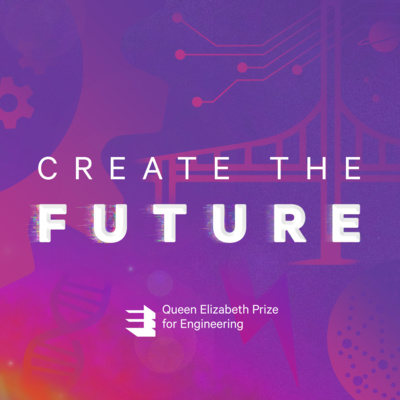
Conservation Engineering: Saving Nature
Shah Selbe is a conservationist, engineer, explorer, and entrepreneur developing technology-based solutions to solve some of the planet’s biggest conservation challenges.
A satellite propulsions engineer by training, Shah’s low-cost, often open-source solutions have been implemented in some of the harshest environments here on Earth, including oceans, deserts, glaciers and rainforests. His technologies have monitored species ranging from Sri-Lankan blue whales to Congo’s lowland gorillas.
In this episode of Create the Future, Shah explains his passion for ‘wild engineering’, exploring, and all the ways in which GPS trackers, drones, camera traps, sensors, satellites, and open-source solutions can help conserve threatened species, populations, and environments.
New episodes of ‘Create the Future: An Engineering Podcast’ every other Tuesday. www.qeprize.org/podcasts

COVID-19: An Engineering Response
Chris Toumazou is one of the world’s leading medical engineers, recognised for his ingenious electronic medical diagnosis and therapy devices.
His latest device ‘CovidNudge’, is an innovative, lab-free, cartridge-based COVID-19 PCR test that combines advances in microfluidics, biochemistry, and electronic engineering to deliver test results in just over an hour, dramatically accelerating testing workflows. The same cartridge can simultaneously test for FluA, FluB and RSV. But how does it work?
In this episode of Create the Future, we speak to Chris about the engineering behind his inventions and hear how an entirely different epidemic informed his rapid pandemic response. We unpack the close-to-home inspiration for his work, discuss the future of modern healthcare, and hear why Chris’ mobile phone miniaturisation background applies perfectly to medicine.
New episodes of ‘Create the Future: An Engineering Podcast’ every other Tuesday. www.qeprize.org/podcasts
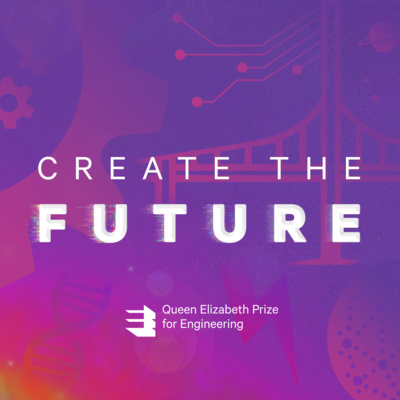
Gitanjali Rao: The 15-Year-Old Using Tech To Change Lives
TIME Magazine’s first-ever ‘Kid of the Year’, Gitanjali Rao, is on a mission to create a global community of young innovators.
At just 15 years old, Gitanjali has already invented an impressive number of life-changing tools. From a portable device that speeds up the process of lead detection in drinking water to an early prescription opioid addiction diagnosis tool, Gitanjali is no stranger to using science and engineering for global good.
In this episode of Create the Future, we speak to Gitanjali about the origins of her passion for STEM and discuss her ongoing mission to inspire others worldwide – she’s already mentored an incredible 40,000 students! We explore the engineering behind her innovations, find out where she draws her inspiration, and hear why baking is an essential tool for any engineer.
New episodes of ‘Create the Future: An Engineering Podcast’ every other Tuesday. www.qeprize.org/podcasts

Understanding Engineering Failure
Henry Petroski is interested in engineering when it succeeds, but more so when it fails.
A distinguished author and professor of both civil engineering and history, Petroski has authored 19 books and written hundreds of articles on the subject of engineering for newspapers, trade journals, and magazines. His books can often be found at the top of engineering ‘must read’ lists.
In this episode of Create the Future, we speak with Petroski about the importance of failure in successful engineering and discuss what we can learn from previous mistakes. We unpack the differences between scientists and engineers, explore how writing can help solve complex design problems, and hear why the best students are often those who can think outside the box.
New episodes of ‘Create the Future: An Engineering Podcast’ every other Tuesday. www.qeprize.org/podcasts
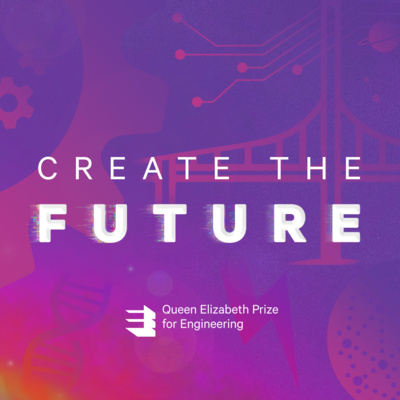
Geoengineering: Carbon Capture
Direct air capture (DAC) technology has been in the news a lot recently following the announcement of Elon Musk’s one-hundred million dollar carbon sequestration competition, but how does the technology work?
In this episode of Create the Future, we are joined by Nathalie Casas, a chemical engineer and Head of Research and Design at Climeworks, the world leader in carbon dioxide DAC technology.
Climeworks’ innovative modular carbon capture technology is powered by renewable energy and has the smallest land and water requirement of all carbon dioxide removal techniques – including afforestation. Though DAC is no silver bullet to the climate problem, we hear how the air-captured CO2 can be permanently stored underground or recycled into climate-friendly products such as renewable fuels, fertiliser, or the bubbles in your favourite soft drink. Nathalie also shares her experiences working for a start-up, imparts advice to budding engineers, and describes her weekend penchant for sailing on Lake Zurich.
New episodes of ‘Create the Future: An Engineering Podcast’ every other Tuesday. www.qeprize.org/podcasts

2021 QEPrize Winners: LED Lighting
In this special episode of Create the Future we speak to the winners of the 2021 Queen Elizabeth Prize for Engineering, the creators of LED lighting.
Solid state lighting technology has changed how we illuminate our world. It can be found everywhere from digital displays and computer screens to handheld laser pointers, automobile headlights and traffic lights. Today’s high-performance LEDs are used in efficient solid state lighting products across the world and are contributing to the sustainable development of world economies by reducing energy consumption.
Hear Nick Holonyak Jr, M. George Craford, Russell Dupuis, and Shuji Nakamura recount tales from the 60-year LED lighting development story, reflect on their individual contributions (and that of fellow winner Isamu Akasaki), and discuss the truly remarkable engineering behind LEDs.
To learn more about the winners and the history of LED lighting, visit: https://qeprize.org/winners/led-lighting
New episodes of ‘Create the Future: An Engineering Podcast’ every other Tuesday. www.qeprize.org/podcasts
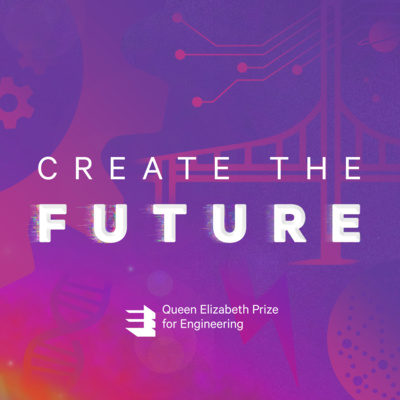
The War on Waste
Veena Sahajwalla is revolutionising recycling.
As the engineering brains behind “green steel” and the world’s first e-waste microfactory, she is leading the way on “green materials” – products and resources made entirely, or primarily, from waste. From plastic bottle derived furniture to steel made from old tires, her goal is for people to see waste not as a problem, but as a useful resource.
In this episode of Create the Future, we speak with Veena about the limitations of conventional recycling and discuss the engineering required to disrupt the status quo. We unpack the environmental and economic benefits of her work, explore the troubling rise of e-waste, and hear how growing up in Mumbai fuelled her lifelong passion for repairing.
New episodes of ‘Create the Future: An Engineering Podcast’ every other Tuesday. www.qeprize.org/podcasts

Creativity in Engineering
For Yewande Akinola MBE, engineering is all about staying curious, expressing creativity, and imagining the impossible.
Yewande Akinola is an award-winning chartered engineer, communicator, and role model. In 2020, she received an MBE in the Queen’s New Year Honour’s list for services to Engineering Innovation and Diversity in STEM.
Inspired to become an engineer owing to the intermittent water supply she experienced growing up in Nigeria, she now specialises in sustainable water management, working on projects in Africa, Asia, Europe, and the Middle East.
In this episode of Create the Future, we explore Yewande’s varied career, from sustainable waterparks to television presenting on National Geographic. We discuss the importance of engineering mentors, her passion for communication, and how creativity (embracing culture, art, and music) is an essential tool for any engineer.
New episodes of ‘Create the Future: An Engineering Podcast’ every other Tuesday. www.qeprize.org/podcasts

Making Waves: Renewable Energy
With approximately 71 per cent of the Earth’s surface covered in water, the predictable and consistent electricity-generating potential of the oceans remains a largely untapped resource.
In this episode of Create the Future, we speak to Sam Etherington, the engineer and entrepreneur behind Aqua Power Technologies Limited’s innovative wave energy generators.
Inspired by the wingspan of a manta ray, Sam’s new four-metre tall submersible, MANTA, is currently being put to use in offshore fish-farms and aquaculture. Unlike expensive and polluting diesel generators, these devices work instead by simply harnessing the rise and fall of ocean waves.
We explore Sam’s entrepreneurial journey from design and development to manufacturing, unpack how kitesurfing – or more specifically, being buffeted off the board – inspired his work, and learn about the search for simplicity in commercial product design.
New episodes of ‘Create the Future: An Engineering Podcast’ every other Tuesday. www.qeprize.org/podcasts
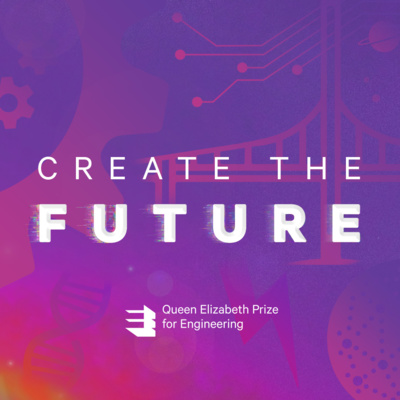
Biochemical Engineering
The heart of the biotechnology revolution, biochemical engineering has seen the launch of entire industries. Biochemical engineers work to develop sustainable solutions to some of our greatest challenges – whether that’s creating better biofuels and biodegradable plastics, or advancing large-scale pharmaceutical manufacturing during pandemics.
From the discovery and manufacture of penicillin in 1918, the extraction of nature's undiscovered potential is no less important today, sitting at the intersection of engineering, maths, biology, and chemistry.
The problem, however, comes when applying traditional engineering principles and practices to biology. Unlike the underlying principles building something more static like a bridge, nature rarely offers a consistent framework to build upon; it changes, ever evolving. Applying engineering to nature requires a shift in thinking. Synthetic biology is all about learning from nature, and adapting that to create solutions for the benefit of humanity.
In this episode of the Create the Future podcast, we speak to Kristala Prather, the Arthur D. Little Professor of Chemical Engineering at MIT and Principle Investigator of the Prather Research Group.
We unpack Kristala's work in biochemical engineering and synthetic biology and her route into the profession, explore why nature throws out the traditional rulebooks of engineering, and discuss ways to make STEM more accessible to future generations.
New episodes of ‘Create the Future: An Engineering Podcast’ every other Tuesday. www.qeprize.org/podcasts

Building The Burj Khalifa
Standing a staggering 828 metres tall, comprised of more than 4,000 tonnes of structural steel, and setting nearly a dozen world records with its construction, the Burj Khalifa is immense. Not only is it a leviathan amid Dubai’s cityscape, but it currently dwarfs every other building on the planet as well. Even during the design process, the building grew from the initial proposal by almost the height of the Eiffel Tower.
Just over a decade since it opened, the Burj Khalifa is today iconic. It has been photographed by millions of people travelling from around the world, and it also played a key role in one of the most gripping stunt acts in recent years alongside Tom Cruise in Mission Impossible.
In this episode of Create the Future, we speak with the structural engineer behind the world’s tallest building: William F. Baker. We speak with Bill about his extensive career working on large scale structures and the technical challenges he’s found that come with them. We explore the relationship between architecture and engineering and the role of design in the construction process, unpack Baker’s “top five” projects to date, and hear his advice for students looking to study structural engineering in an increasingly digital age.
New episodes of ‘Create the Future: An Engineering Podcast’ every other Tuesday. www.qeprize.org/podcasts

Bill Nye: The Science (and Engineering!) Guy
Just as internet pioneer Vint Cerf is known for donning a three-piece suit, so too is this week’s guest known for their accoutrement of choice: a bow tie.
Whether you grew up in the US or not, chances are you’ve heard of Bill Nye. His titular show, Bill Nye the Science Guy, ran for five years in the mid-1990s, winning 19 of the 23 Emmys it was nominated for. Its combination of comedy and accessible educational content proved immensely popular, garnering an international audience while demonstrating that science can be for everyone. Not only did the show inspire a generation to study STEM, but its long-term success is now inspiring new generations as well.
Since the show’s conclusion in 1998, Nye has continued to promote science around the world – holding public lectures, hosting new shows, writing books, presenting podcasts, as well as doing the odd film and television cameo. So while many of us have grown up associating Nye with science, it might come as a shock to some to learn that he's also a mechanical engineer.
In this episode of Create the Future, we explore Nye’s exciting career as a scientist and engineer. We learn the origins of his iconic attire and his debut on television, discuss the impact of a career in engineering, and hear how he successfully campaigned to get sundials installed on both the Spirit and Opportunity Mars rovers.
New episodes of ‘Create the Future: An Engineering Podcast’ every other Tuesday. www.qeprize.org/podcasts
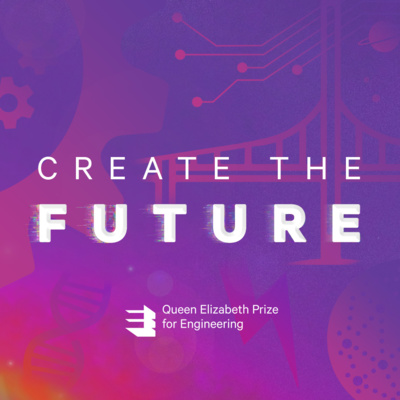
A Driverless Future
Today’s technologies would be considered magic to people just a few decades past, but the ideas behind them are often far from new. The promise of a driverless future, for example, may seem to many like it arrived in the last decade, but it’s been both “just around the corner” and symbolic of the future for the past century.
The first driverless ground vehicle technically appeared in 1904, a radio-controlled tricycle developed by Leonardo Torres-Quevedo. In the 1920s, remote-controlled “phantom autos” drove through Ohio that could reportedly be operated from up to five miles away. The concept of a self-driving or ‘autonomous’ car then entered the mainstream in 1939, in an exhibit at New York World’s Fair that predicted America’s future in 1960.
After early prototypes debuted in the 1960s and 70s, the capability of autonomous vehicles has slowly improved alongside developments in parallel technologies. Today, the basic hardware is well established – almost all vehicles come with a combination of radar, cameras, LIDAR, GPS, and so on – and rapid advances in computing power have significantly improved the software side by making deep neural networks much more practical.
When the driverless future does become a reality, then it could cause paradigm shifts at multiple levels of society. It’s more than just a source for convenience, it could democratize transportation, reduce emissions, help to improve agricultural yield, and more.
The barrier to getting there is safety. One of the main reasons why it’s so difficult to build a commercial product is that it's no longer about just demonstrating that it works – it’s about guaranteeing that it works safely, and reliably. This isn’t even just in terms of the driving itself; the surrounding infrastructure, and potential problems with hacking and privacy breaches, are equally important factors.
So how long will it be until we get this peace of mind and, when we do, will people still retain some level of control? How do self-driving cars even work, for that matter?
In this episode, we discuss all of this and more with a “rockstar” of autonomous vehicles: Nvidia’s Justyna Zander. We explore why the driverless future has been slower to arrive than expected, the future of autonomous transport and its benefits, and the differences between a machine-based driver and a human.
New episodes of ‘Create the Future: An Engineering Podcast’ every other Tuesday. www.qeprize.org/podcasts

Microwaves to Musical Robots: A Career in Engineering
Danielle George is a Professor of Microwave Communication Engineering at the University of Manchester and the incoming President of the Institution of Engineering and technology.
Starting her career as a scientist, Danielle studied astrophysics at university. However, she quickly discovered the allure of engineering and, after choosing the more practical subjects during her studies, secured her very first job as a junior engineer working on the Planck satellite.
Today, Danielle’s research is largely dedicated to engineering the tools of scientific discovery – one of the 14 grand challenges for engineering in the 21st century. She is the UK lead for amplifiers in the Square Kilometre Array (SKA) project and has worked with NASA and the European Space Agency to further our exploration of the Big Bang.
Danielle is just as likely to be seen in the mainstream media. She makes regular appearances on TV programmes and podcasts, raising public awareness of the global positive impact of engineering and informing the next generation of the myriad opportunities a career in STEM can offer. In 2014, she became the sixth woman to deliver the Royal Institution Christmas Lecture since its inception in 1825. She was honoured with an MBE and awarded the Royal Academy of Engineering’s Rooke Award for the Public Promotion of Engineering in 2016, and the Michael Faraday Prize by the Royal Society in 2018.
In this episode of Create the Future, we explore Danielle’s varied career from her work on the Planck satellite through to her current projects such as the Square Kilometre Array (SKA) telescope. We discuss the importance of science communication in the mainstream media, her reflections on International Women in Engineering Day, and what it was like to co-found the world’s first recycled robot orchestra.
New episodes of ‘Create the Future: An Engineering Podcast’ every other Tuesday. www.qeprize.org/podcasts
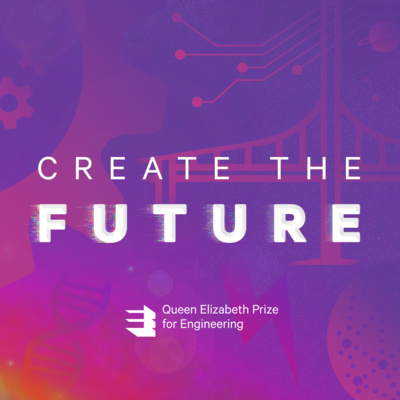
City Skylines With Roma Agrawal
Often considered to be the world’s first skyscraper, the Home Insurance Building was completed on 1 March 1885, on the corner of Adams and LaSalle Street in Chicago. At 138 feet (42m) high, it wasn’t the tallest building in Chicago at the time – but its historical significance stems not from its height, but its engineering.
Made possible by several technological breakthroughs at the time, the Home Insurance Building differed from traditional construction methods by using a structure made from iron and, more importantly, steel. This gave it a unique architecture and weight-bearing frame. Compared to previous building designs – which had reached a practical height limit to avoid their weight-bearing masonry walls getting too thick and heavy – this new design proved lighter, stronger, and a more practical way to increase height.
Though there is debate over whether the Home Insurance Building was “the first skyscraper”, or indeed the first to use a steel frame, a combination of other factors helped it to popularize the idea. It provided a template for the second and third generation skyscrapers surrounding us today; it enabled, over a century later, the myriad of unique city skylines we now see around the world.
London’s skyline, in particular, has seen immense change over the centuries. Today, you need only turn your head to see yet another iconic structure towering above you: the “Walkie-Talkie”, “Gherkin”, or “Cheesegrater” for example. But with the number of skyscrapers continuing to grow, how do we future proof them to account for people’s needs decades or centuries into the future? How do we ensure that they complement their surroundings while still encouraging innovation? On what metrics do we define a good or successful structure?
We answer these questions in this episode of Create the Future with Roma Agrawal, a structural engineer who spent six years working on one of London’s most recent and distinctive additions: the Shard. We also speak to Roma about her work promoting engineering as a career, why female representation in engineering varies so significantly around the world, and what it was like to be photographed by Annie Leibovitz alongside Emma Thompson and Rita Ora.
New episodes of ‘Create the Future: An Engineering Podcast’ every other Tuesday. www.qeprize.org/podcasts
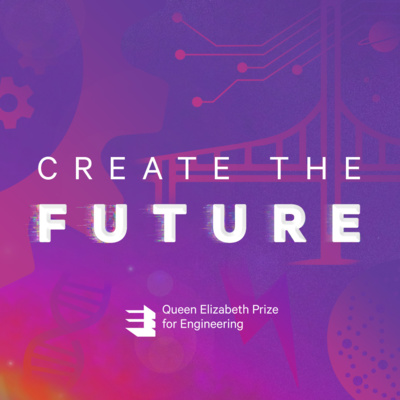
Origami Engineering
Fold by fold, engineers have begun to recognise the innovative potential of origami beyond the traditional paper cranes and flowers. With its applications ranging from ingestible robots to deployable shelters, it is easy to see why the ancient art form has many excited for the future of robotics, medicine, and spaceflight.
Inspired by unfurling insect wings, foldable structures have been used for their space-saving benefits in spaceflight for some time; the Japan Aerospace Exploration Agency (JAXA) used the Miura fold for their 1995 Space Flyer Unit, and NASA is following suit in their upcoming James Webb Space Telescope. Increasingly, the mathematical laws of origami are being applied to engineering – helping to create tools without the need for complex internal mechanisms.
In this episode of Create the Future, we speak to Dr Mark Schenk, an aerospace engineer whose childhood interest in origami led to his innovative work on morphable and deployable structures that might – one day – lead to a future without hinges or springs. We learn how to save weight when building aeroplanes, discuss the implication of ‘soft robotics’ in factories and warehouses, and hear why Mark insists on showing his engineering students an Anglepoise lamp during their first lecture.
* This episode was recorded early in 2020 before any lockdown measures were implemented.
New episodes of ‘Create the Future: An Engineering Podcast’ every other Tuesday. www.qeprize.org/podcasts
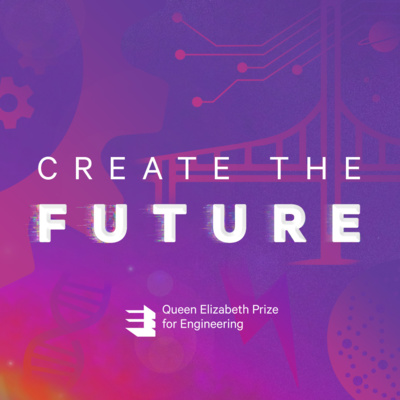
Painting In Space With Astronaut Nicole Stott
If you’ve ever stared up at the night sky with curiosity and a sense of wonder, then this week’s episode of the Create the Future podcast is for you.
This month, two huge engineering achievements are being celebrated. The first is the 50th anniversary of the Apollo 13 mission, where engineers rescued astronauts from sudden disaster; the second is the 30th anniversary of the launch of the Hubble Space Telescope, which forever changed our perception of the universe in terms of both science and, through its stunning astronomical images, art.
In this episode of Create the Future, we speak to someone whose career has combined all of this: former astronaut, engineer, and artist Nicole Stott. We speak to Nicole about her experiences in spaceflight and what it takes to become an astronaut, how living on the International Space Station compares with life in quarantine, and what it was like to paint the first watercolour, in orbit, at 17,500 miles per hour.
New episodes of ‘Create the Future: An Engineering Podcast’ every other Tuesday. www.qeprize.org/podcasts
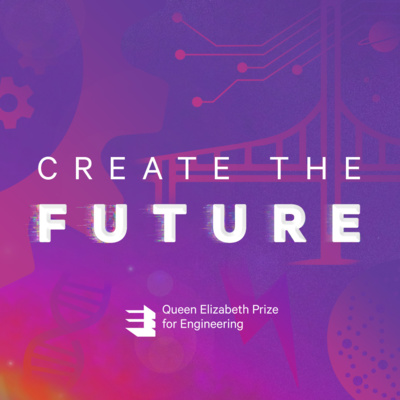
Vint Cerf: Engineering the Internet
Whether you're streaming your favourite TV show, video conferencing with colleagues, posting a photo of your food on Instagram, or helping to build a to a global, community-driven supercomputer – you need the internet.
Throughout history there have been several feats of engineering that have forever changed the way that we communicate, and how we see our world – inventions such as the printing press, the telegraph, and the steam engine all fundamentally altered daily human life. One of the most recent of these life-changing innovations is the internet. With around 4.5 billion people online in 2020, few other innovations can compare to the internet’s sheer ubiquity, speed, and global impact.
This ‘network of networks’ is pervasive; it's created a degree of global connectivity that would not have been thought possible 50 years ago. With just a few clicks, we can work with people thousands of miles away, keep up to date with local or global news, monitor core infrastructure, and learn a variety of new skills. There’s also a lot of pet videos to watch.
The internet is now weaved through nearly every aspect of modern life and yet, despite this familiarity we have with it, for most people there are still a lot of unknowns. How does an email actually travel from place to place? Is access to information a human right or is it owned by corporations? Is fake news here to stay? Can we make an internet in space?
In this episode of Create the Future, we answer those questions with one of the internet’s creators: QEPrize Winner, Chief Internet Evangelist, and trademark three-piece suit wearer, Vint Cerf. We explore his work creating the fundamental protocols of the internet, unpack what it means to evangelise the internet, and discuss the biggest challenges that face the internet’s future.
New episodes of ‘Create the Future: An Engineering Podcast’ every other Tuesday. www.qeprize.org/podcasts

Exploring the Quantum Realm With Jim Al-Khalili
If you’ve ever heard of Schrödinger’s cat, watched Avengers: Endgame, or binge-watched The Big Bang Theory, then a branch of physics called quantum mechanics may sound familiar. Quantum mechanics (or quantum theory) is one of two theories in physics that work to describe the fundamental properties of the universe, the other being Einstein’s theory of relativity.
Science fiction has wrapped quantum mechanics, which focuses on the atomic level, with an intimidating veil of esoterica and counterintuitivity – teleportation, things being in two places at once, particles also existing as waves, and so on. But the fact is a lot of the things we rely on every day wouldn’t exist without it. Smartphones, MRI scans, GPS, and even the structure of the internet rely on fundamental universal principles that it explains.
However, there has been much debate about whether the principles of physics and chemistry that underpin inanimate objects could also apply to biological systems. Enter quantum biology, a currently speculative field focused on studying biological systems through the lens of quantum mechanics. In the next decade or so, it could help to improve our understanding of a whole swathe of biological phenomena – DNA mutations, photosynthesis, and even the migration patterns of birds.
In this episode of Create the Future, we talk to someone well-versed in the intersectional study of quantum biology: QEPrize Judge Professor Jim Al-Khalili. We speak to Jim about his work and what he describes as the 'dawn of quantum bioengineering’. We also explore how Einstein's theory of relativity affects GPS, the relationship between science and engineering, and the important roles that both play in society.
New episodes of ‘Create the Future: An Engineering Podcast’ every other Tuesday. www.qeprize.org/podcasts
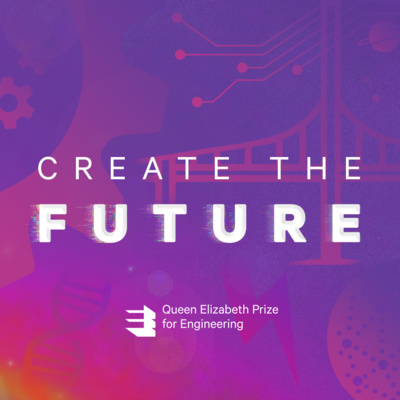
Hollywood Magic: Engineering in the Movies
Bringing a touch of Hollywood glamour to Create the Future this week, we interview two visual effects (VFX) engineers whose companies have, between them, received Oscar nominations for visual effects on the Lion King, Gladiator, Life of Pi, the most recent Jungle Book, and won an Oscar for the hugely successful World War 1 movie, 1917.
Unlike special effects – explosions, animatronics, and atmospheric conditions created on set – visual effects are added to a scene digitally during post-production. Visual effects have created some of the most iconic scenes in modern cinema – the liquid metal terminator in Terminator 2, the dragons in Game of Thrones, and the magic in Harry Potter. But good visual effects are more than just visual entertainment; they add to the story that the creatives are trying to tell. Often, when they’re done well enough, we don’t notice them at all.
In this episode, we explore the crucial role of visual effects in storytelling across cinema, television, and advertising with Roy Trosh, Vice President of Global Systems Architecture at Technicolour, and David Spilsbury, Chief Technology Officer for advertising at the Moving Picture Company (MPC) in Soho London. We learn about their journeys into engineering, explore how to make a swimming pool in space, and discover why and how VFX engineers ‘chase the sun’.
New episodes of ‘Create the Future: An Engineering Podcast’ every other Tuesday. www.qeprize.org/podcasts

Earthquake Engineering: Predicting Mother Nature
Earthquakes provide a complex challenge for engineers; they are difficult to predict, difficult to withstand and, subsequently, difficult to recover from. But that’s not all – as seen by the 2004 Indian Ocean and 2011 Tōhoku earthquakes, these events can also trigger unforeseen secondary disasters such as tsunamis and nuclear meltdowns, increasing the scale of the disaster several fold.
According to the United States Geological Survey, in an average year an estimated several million earthquakes occur around the world. Thankfully, most of these go undetected because they are in remote areas or are too small to register. However, 18 of these are typically major earthquakes that reach over magnitude 7 on the Richter scale. As a sense of scale, the 8.9 magnitude earthquake that hit Japan in 2011 was so intense that it altered the distribution of the Earth's mass. As a result, it caused the earth to rotate slightly faster and has fractionally shortened the length of each day.
So how do you design our infrastructure to resist that? How do you determine the specific impact that an earthquake will have from region to region? While it was once a narrower discipline, earthquake engineering today combines several engineering fields with elements of sociology, political science, and finance in order to predict and mitigate the effects of these disasters.
In this episode of Create the Future, we speak with seismic expert Ziggy Lubkowski about the impact of earthquakes around the world, the origins of ‘flexible’ buildings, and how we can build more resilient structures in the future.
New episodes of ‘Create the Future: An Engineering Podcast’ every other Tuesday. www.qeprize.org/podcasts

The Eighth Wonder of the World: The Panama Canal
Opened over a century ago, the Panama Canal is widely considered to be one of the greatest feats in engineering history, and a contender for the ‘eighth wonder of the world’. Not only did its construction produce the biggest earth dam in the world at the time, but it also, consequently, produced the largest artificial lake.
The Panama Canal allows ships to travel from the Atlantic Ocean to the Pacific Ocean through a 48-mile-long shipping route, saving over 15,000 kilometres around the South American continent. That’s the distance from London to Queensland.
Acting as a water elevator, the canal lifts ships up and down by 26 meters through a mountain range. In 2019 alone, the Panama Canal transported several thousand vessels and a quarter of a million metric tonnes of goods.1
In this episode of Create the Future, we speak with QEPrize Judge Ilya Espino de Marotta about the history of the Panama Canal and her key role in its expansion as the appointed Executive Vice President for Engineering, the first woman in history to hold the position. We also hear about Ilya’s entry into – and career in – engineering, her thoughts on becoming a judge for the Queen Elizabeth Prize for Engineering, and her decision to wear a pink hard hat at work.
New episodes of ‘Create the Future: An Engineering Podcast’ every other Tuesday. www.qeprize.org/podcasts

The Origins of GPS
Today we take our navigation for granted. Just a few moments using our phone and we’ve got our quickest route home, the scenic drive to work, and directions to the nearest coffee shop. But have you ever stopped to wonder how it actually works, or who made it?
For a special sixth episode of the Create the Future podcast, we spoke to the winners of the 2019 Queen Elizabeth Prize for Engineering after they received the award from HRH The Prince of Wales, about their work developing the Global Positioning System – GPS.
Today, it is estimated that four billion people around the world use GPS. It provides an accessible service for all and a powerful tool that engineers can integrate with their own applications for free. It can help to track disease outbreaks, guide self-driving tractors, prevent shark attacks, and even improve the performance of sports teams. New applications for GPS continue to revolutionise entire industries, and its annual economic value has been estimated to be $80 billion for the USA alone.
In this episode, Dr Bradford Parkinson, Richard Schwartz, Hugo Fruehauf, and Anna Marie Spilker, on behalf of her late husband, Professor James Spilker, Jr, recount stories of how they started working on GPS, their individual contributions to the project, the highlights and challenges of the colossal innovation, as well as their thoughts on its future applications.
To read more about the winners, and the history of GPS, visit: qeprize.org/news/origins-of-gps
New episodes of ‘Create the Future: An Engineering Podcast’ every other Tuesday. www.qeprize.org/podcasts

A Material World
From swimsuits and coffee cups to quantum computers and medicines, materials science – the “middle of the Venn diagram between chemistry, engineering, and physics” – enables all the products, substances, and general ‘stuff’ with which we interact every day.
But what makes for a good material? What makes a material ‘smart’, for that matter? And, while new, more advanced materials can help to power industries far into the future, at what cost do we make them more complex, and less degradable?
Joining us in our ‘materials’ episode of Create the Future are materials experts Anna Ploszajski, materials scientist and research fellow at the Institute of Making at University College London; and Tim Minshall, Professor of Innovation and Head of the Institute for Manufacturing at the University of Cambridge.
New episodes of ‘Create the Future: An Engineering Podcast’ every other Tuesday. www.qeprize.org/podcasts
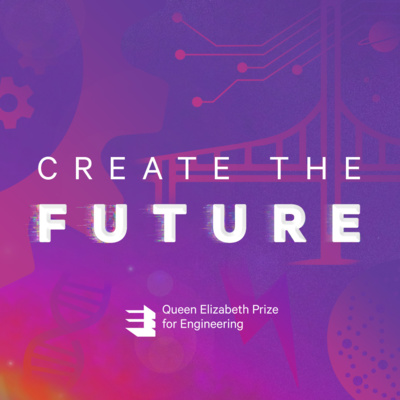
Alexa, Can You Hear Me?
The fourth episode of the Create the Future podcast focuses on artificial intelligence, a topic often found at the centre of modern ethical discourse, and one that frequents both the cinema screens of Hollywood, and the pages of science fiction.
Joined by experts Dame Wendy Hall, professor of computer science at the University of Southampton; and Azeem Azhar, technology entrepreneur and producer of the Exponential View newsletter and podcast, we talk about the benefits of AI, as well as its ethical issues, its future, and why we should proceed with caution in its development.
New episodes of ‘Create the Future: An Engineering Podcast’ every other Tuesday. www.qeprize.org/podcasts

Smart Cities: All Hype or a Platform for Change?
In this episode, we explore the origin and potential impact of smart cities. We look back on the technological and economic successes of the 2012 Olympic Games; debate the use of people’s data to improve city infrastructure; and highlight the need to ensure that smart city technology is developed to be inclusive, not a commodity.
Joining us in this conversation are Dr Larissa Suzuki, senior product manager for automatic machine learning at ORACLE; and Andrew Comer, director of the cities business unit at BuroHappold Engineering.
New episodes of ‘Create the Future: An Engineering Podcast’ every other Tuesday. www.qeprize.org/podcasts

Moon Landing and Mars Rovers: Our Forays Into Space
In this episode, in celebration of the 50th anniversary of the Moon landing, we talk with Apollo engineer Dr David Baker and then traverse the surface of Mars with Airbus ExoMars rover engineer Abbie Hutty.
New episodes of ‘Create the Future: An Engineering Podcast’ every other Tuesday. www.qeprize.org/podcasts
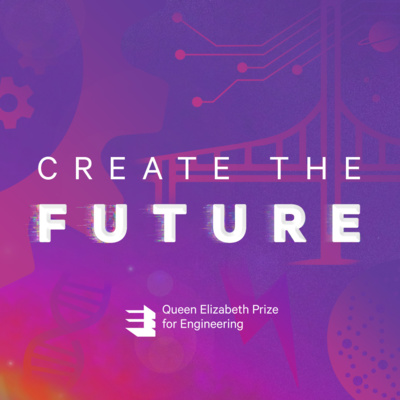
The World Around Us
In this inaugural episode we talk with Lord Browne of Madingley, engineer, business leader and Chairman of the Queen Elizabeth Prize for Engineering Foundation, about the profound impact that engineering has, and continues to have, on the world around us.
New episodes of ‘Create the Future: An Engineering Podcast’ every other Tuesday. www.qeprize.org/podcasts